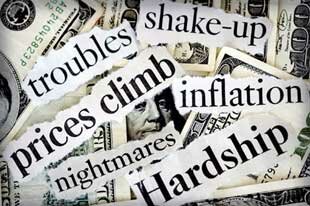Unemployment Up, Stocks Up!
Ordinary, average, struggling Americans might be scratching their heads over the news today, as the Labor Department reports that unemployment is up by four-tenths of a percent for the month to a record 10.2%, fully three-tenths of a percent higher than economists had been forecasting, and stocks do what? Rise by a quarter of a percent!
What’s going on here?
Well, the tube analysts are quick to say, unemployment figures are a “lagging” indicator. That is, employment generally lags the overall economy, with layoffs coming after a recession kicks in, and hiring waiting until a recovery is well underway.
But that isn’t true with a deep recession like this one, because at some point—and we’re well past that point—high and pro-longed unemployment leads to reduced demand for goods and services, and to a psychology of fear and consumer withdrawal. Once people feel that they aren’t going to find a new job soon, and once those who still have jobs feel that their employment is not secure, they no longer buy things except what they absolutely need.
And in an economy where fully 72% of economic activity is consumer spending, that is no longer a “lagging indicator.” High, prolonged unemployment becomes a causal factor in the economic downturn.
If people aren’t buying stuff, then companies won’t make it, which means that they stop hiring, and even lay more people off, and so unemployment becomes a downward spiral of cause and effect.
But what about the stock market rise? Why would investors think that a worse-than-expected jobs report is a good thing?
There are several explanations for this ugly phenomenon. First of all, rising unemployment—particularly sharply rising unemployment—means that the Federal Reserve will definitely not, for the foreseeable future, raise interest rates. A rise in interest rates would hit companies hard, and always batters the stock market, and the government and the Fed don’t want to do either of those things.
So investors almost always jump into the market and push stocks up when they get some signal that the Fed is going to lower, or at least hold the line on interest rates. With rates effectively set at 0, the Fed can’t lower them, but it is saying, no doubt with the bad news about unemployment in mind, that it won’t be raising them anytime soon.
But there is another reason high unemployment may excite investors. Current layoffs are likely, for many workers, to be permanent. A recent report that productivity—work output per worker—was up at a 9.55 annual rate in the Third Quarter, is an indication that those companies that haven’t shut down operations are making or doing more with fewer workers. That kind of thing happens in recessions, because as joblessness gets worse, those workers who still have jobs become more docile and are willing to be worked harder by management.
Of course, you get more on-the-job injuries, more stress-related illness, etc. along with that kind of speed-up, but over the shorter term, it looks good on the books if you’re cranking out more product with a lower payroll.
Of course, longer term, this is all a disaster, not just for laid-off and afraid-to-be-laid-off workers, but for the country as a whole. You can’t rebuild an economy with more than one-in-ten workers unemployed. And remember, that’s just the people who are our of a job and still looking for one; it doesn’t count those who have been out of work for so long, or who work in professions that are so gone (like construction or maybe manufacturing Saturns) that they’ve just given up looking, or those who have taken part-time jobs in ice-cream parlors or selling apples to survive but who want to be fully employed again.
If you add those people into the mix (which is the way the US used to count unemployment until the 1980s), you get an unemployment rate closer to 20%, or one in five! And you sure can’t rebuild an economy with one in five workers unemployed.
That’s what makes all the happy talk in the news and in Washington about the recession being over because last quarter showed a 3.5% annualized jump in the so-called Gross Domestic Product so ridiculous.
Most of that rise was the result of government subsidies to car-buyers and first-time house buyers. It was a one-shot stimulus that pushed forward spending, but it was no indication of a recovering economy, just a spasm of spending using taxpayer money.
Furthermore, an excellent article in Businessweek by Michael Mandel noted that fully one-percent of that GDP gain was the result of a failure by government economists to account for a collapse in corporate spending on research and development and on training and retaining intellectual assets (a complicated way of saying that engineers, scientists and technology workers were being laid off at a higher rate than other workers, and much R&D work was being shipped overseas for good), So really the “growth” of GDP in the third Quarter should have been at a 2.5% rate, and even that was largely government pump priming, not recovered economic activity.
The truth is, we’re falling deeper into recession, and apparently, according to the October unemployment figures, at an accelerating rate. And there is no indication that the Obama Administration or the Democratic Congress are planning any significant jobs-creation program. They seem to be happy with this.
So quick, run out and buy some stock! It’s the American thing to do. Probably not a bad idea either, since those dollars you are using will keep sinking in value as long as the Fed is constrained from jacking up interest rates.
Dave Lindorff is a Philadelphia-based journalist and columnist. His latest book is “The Case for Impeachment” (St. Martin’s Press, 2006 and now available in paperback). He can be reached at
Source: Guardian
MSN - - - Wikipedia - Hamsayeh.Net



